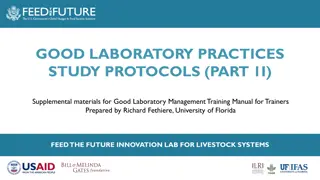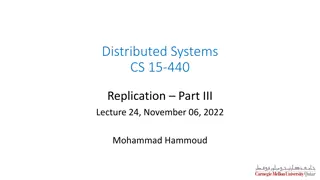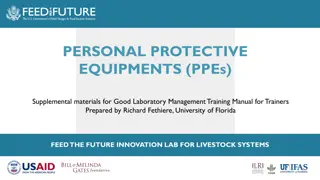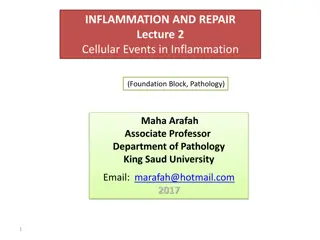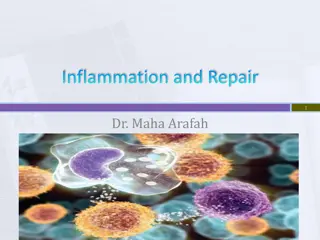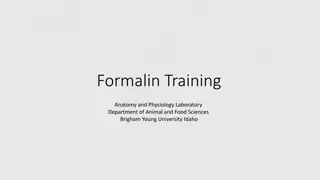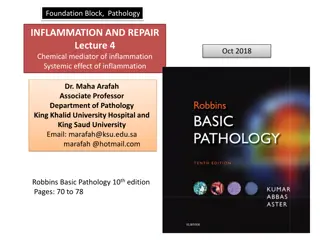Understanding Safety Protocols and Inflammation in Histotechnique Laboratory
Safety in the histotechnique laboratory is crucial to prevent exposure to infectious agents like prions. Proper decontamination methods, such as formalin and formic acid treatment, are essential for handling tissues from suspected patients. Additionally, precautions should be taken to avoid airborne particles when sectioning tissues. Understanding inflammation and its cardinal signs, like rubor and tumor, is vital in recognizing tissue responses to injurious agents.
Download Presentation

Please find below an Image/Link to download the presentation.
The content on the website is provided AS IS for your information and personal use only. It may not be sold, licensed, or shared on other websites without obtaining consent from the author. Download presentation by click this link. If you encounter any issues during the download, it is possible that the publisher has removed the file from their server.
E N D
Presentation Transcript
Safety in the Histotechnique Laboratory PEL Permissible Exposure Limit TLV Threshold Limit Value OEL Occupational Exposure Limit
*Complete penetration by alcohol will destroy all infectious agents except prions. Prions are infectious agents that cause spongiform encephalopathies such as Creutzfeld-Jakobdisease (CJD), scrapie and mad cow disease. Normal steam sterilization does not inactivate these particles, and common effective treatments like sodium hypochlorite or phenol will create artifacts in tissue.
Tissue from suspected patients with CJD can be decontaminated by immersing the specimen in formalin for 48 hours, followed by treatment in concentrated formic acid for 1 hour and additional formalin fixation for another 48 hours.
Small-dust particles generated from sectioning may become airborne, particularly when performing cryostat sections of fresh tissue. Cryogenic sprays can magnify this risk, and therefore should not be used to freeze potentially infectious tissue.
Cytopathologic Changes in Disease Inflammation is the sum total of changes in the living tissues, in response to an injurious agent, including the local reaction and the repair of an injury. - it is composed of a series of physiologic and morphologic alterations in the blood vessels, blood components and surrounding connective tissue, for the purpose of protecting the body against injury.
Rubor (Redness) due to arteriolar and capillary dilation with increased rate of blood flow towards the site of injury, and concentration or packing of the red cells in the capillaries causing increased viscosity and consequent slowing of the blood flow (stagnation).
Tumor (Swelling) due to increased capillary permeability, allowing the extravasation of blood fluid, associated with increased hydrostatic pressure within the dilated arterioles and capillaries, causing localized edema (tumor) accompanied by escape of blood cells into the injured area, increased concentration of plasma proteins, and accumulation of finely particulate cellular debris caused by destruction of tissue cells and bacteria
Calor (Heat) due to transfer of internal heat to the surface or site of injury, brought about by increased blood content.
Dolor (Pain) due to pressure upon the sensory nerve by the exudate or tumor
Functio Laesa (Diminished Function) may be due to pain interference with nerve supply and to destruction of the functioning units of the tissue.
Causes of Inflammation: Living things (bacteria,parasites) Viruses Non-living agents (physical, mechanical, electrical, or chemical stimuli)
Classification of Inflammation A. duration of the inflammation B. predominant type of exudate formed C. location of the inflammation
A. Types of Inflammation according to duration 1. Acute Inflammation - usually, but not necessarily, of sudden onset and characterized by the classic features of heat, redness, swelling, pain and loss of function.
1. Acute Inflammation - It refers to an inflammatory reaction in which the dominant anatomic changes are vascular and exudative, hence, it is also called Exudative Inflammation, with exudation of white blood cells, predominantly the polymorphonuclear leukocyte.
2. Chronic Inflammation this involves the persistence of the injurious agent for weeks or years, characterized by proliferative (cell multiplication) rather than exudative response, with a predominantly mononuclear cell infiltration (macrophages, lymphocytes and plasma cells).
2. Chronic inflammation proliferation is chiefly fibroblastic and vascular. - polymorphonuclear leukocytes may also be present.
2. Chronic Inflammation continued proliferation of fibroblasts gives rise to considerable damage and scarring with resultant deformities
Granulomatous Chronic Inflammation - this is characterized by formation of granuloma, constituting a distinct histologic pattern of inflammation in certain diseases like Tuberculosis, Syphilis, Lymphogranuloma Inguinale, etc.
Granuloma implies a tumor-like mass of granulation tissue (actively growing fibroblasts and capillary buds).
Subchronic inflammation represents an intergrade between acute and chronic inflammation
Types of Inflammation According to Character 1. Serous Inflammation serous exudation is characterized by extensive outpouring of a watery, low-protein fluid derived from either the blood serum or secretions from the serosal mesothelial cells, i.e. peritoneal, pleural or pericardial cavities. - this is characteristic of certain forms of pericardial tuberculosis with involvement of the pleura (pleurisy with effusion).
2. Fibrinous Inflammation - this is characterized by exudation of large amounts of fibrinogen and the precipitation of masses of fibrin, occuring in the more severe acute inflammations associated with marked endothelial damage, also found in diphteria, rheumatic pericarditis and in early stages of pneumonia. - polymorphonuclear leukocytes are usually trapped within the fibrin meshwork
3. Catarrhal Inflammation - this type affects mucous surfaces and is characterized by hypersecretion of the mucosa with degenerative changes in the epithelium, characteristic of inflammatory involvement of the respiratory, gastrointestinal and other mucus-secreting glands. - this form of exudation is identified by large amounts of faintly basophilic, amorphous, stringy mucoid which usually contains white cells.
4. Hemorrhagic Inflammation - this is characterized by the admixture of blood and other elements of the exudate, the intensity of hemorrhage varying from case to case, and may be found in bacterial and other infections.
5. Suppurative or Purulent Inflammation - this is characterized by production of large amounts of pus or purulent exudate. - Pus may be defined as a thick, creamy fluid composed of large numbers of viable and necrotic polymorphonuclear leukocytes and necrotic tissue debris that is partially liqueified by proteolytic digestion.
Suppuration characterized by large numbers of neutrophils and tissue debris and is most prominent in the early stages of inflammation, its presence denoting an acute reaction
Abnormalities in cell growth Retroregressivechanges: Organs or tissues smaller than normal may be due to: A. Developmental Defects: 1. Aplasia is the incomplete or defective development of a tissue or organ, represented only by a mass of fatty or fibrous tissue, bearing no resemblance to the adult structure - commonly seen in one of paired structures such as kidneys, gonads and adrenals
2. Agenesia refers to the complete non-appearance of an organ 3. Hypoplasia refers to the failure of an organ to reach or achieve its full mature or adult size due to incomplete development. 4. Atresia is the failure of an organ to form an opening
Atrophy refers to an acquired decrease in the size of a normally developed or mature tissue or organ resulting from reduction in cell size or decrease in total number of cells or both.
Pathogenesis of Atrophy Due to increased activity of the proteolytic enzymes associated with deficient blood and lymphatic circulation or increased metabolic activity leading to accumulation of CO2 and organic acids in the cells, ultimately causing loss of cell substance
Types of Atrophy 1. Physiologic atrophy occurs as a natural consequence of maturation, as in atrophy of the thymus and lymphoid tissue during puberty. Sexual organs and brain begin to undergo physiologic atrophy at about 50 years of age
Senile Atrophy occurs in old age characterized by dry, lusterless, wrinkled skin due to atrophy of sweat and sebaceous glands and loss of fat, gray hair, atrophy of the ligaments, brittle bones which easily break, and arcus senilis of the cornea.
2. Pathologic atrophy refers to a decrease in size of tissues or organs, outside the range of normal variability, usually as a consequence of disease.
On the basis of apparent clinical causes, pathologic atrophy may be classified into: A. vascular atrophy (due to lack of nutrition) occurs if the blood supply to an organ or tissue becomes reduced below critical levels, commonly encountered in kidney and brain. - the most common cause is vascular narrowing due to progressive arteriosclerosis, although, external pressures may also play a role.
B. pressure atrophy persistent pressure on the organ or tissue may directly injure the cells or may secondarily promote diminution of blood supply leading to vascular atrophy.
C. starvation or hunger atrophy produces a general wasting of tissues due to excessive lack of nutritional supply necessary for normal growth.
D. Atrophy of disuse inactivity or diminished function of a tissue or organ (as in long standing, chronic illnesses, or inactivity of muscle fibers due to plaster casts or neuropathy) may lead to narrowing of the blood vessels with loss of nutrition and consequent atrophic changes
E. Exhaustion atrophy prolonged overwork, especially of an endocrine organ (e.g. adrenals, pituitary or thyroid) may produce initial enlargement with ultimate slow progressive loss of parenchymal elements due to excessive formation of acid metabolites with subsequent increase of catabolic enzymes
F. Endocrine Atrophy diminished or absent endocrine stimulation may produce functional atrophy of organs which are mainly dependent on their endocrine supply for maintenance of their normal structures.
Pathogenic Changes seen in Atrophy Grossly, atrophic organs are smaller and firmer in consistency due to increased amount of connective tissue; vessels appear prominent and increased in number due to proximity of vessels formerly separated by larger masses of tissue
Pathogenic Changes seen in Atrophy Microscopically, atrophic cells are smaller than normal; the tissue may appear to be relatively cellular Atrophic parenchymal cells, particularly in the heart and liver may contain yellow granular lipid-containing pigments (lipochrome pigment or lipofuscin), imparting on them a brownish discoloration on gross inspection ( Brown Atrophy ).
Progressive Changes Organs or Tissues larger than normal A. Hypertrophy refers to an increase in size of tissues or organs due to increase in the size of the individual cells. Classified into various forms:
1. True hypertrophy usually observed in the skeletal muscles, heart, kidneys, endocrine organs (breast and uterus) and smooth muscles of the hollow viscera (e.g. intestinal tract), due to increased work load and endocrine stimulation (e.g. during exercise and pregnancy)
2. False hypertrophy due to edema fluid and connective tissue proliferation (e.g. in cirrhosis and chronic hypertrophic salpingitis or appendicitis) Salpingitis inflammation of fallopian tubes
3. Compensatory hypertrophy involves one of paired organs when the other opposite organ has been removed or suffered from functional insufficiency
B. Hyperplasia Refers to an increased in size of an organ or tissue due to increase in the number of cells resulting from growth of new cells.
A. Physiological hyperplasia occurring as a normal phenomenon, e.g. in hyperplasia or hypertrophy of the uterus during pregnancy.
B. Pathological hyperplasia brought about by disease as observed in hyperplasia of the lymphoid follicles and peyer s patches of the intestines in typhoid fever.



